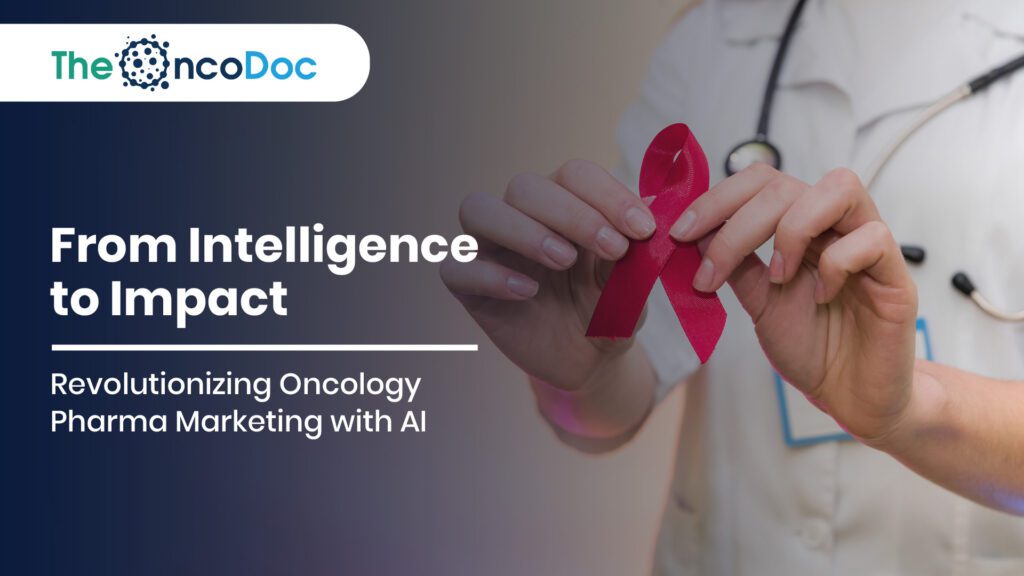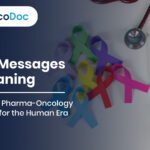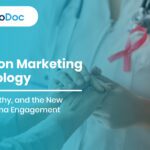Introduction: Redefining the Role of Pharma Marketing in Oncology
In the high-stakes world of cancer treatment, every second counts, and every decision matters. Oncologists face a deluge of emerging treatment options, real-world complexities, and data fatigue. In such a scenario, the traditional model of pharma marketing, centered around loud promotion, static segmentation, and generic messaging, has grown increasingly obsolete.
The oncology landscape now demands marketing that is not only scientifically accurate, but also deeply personalized, contextually relevant, and technologically agile. As Artificial Intelligence (AI) reshapes industries, it offers a potent solution to bridge the growing disconnect between pharma brands and clinical utility.
This article charts a new roadmap where AI empowers pharma marketing to become a critical enabler of clinical decision-making, patient communication, and health system integration, moving from digital noise to real-world impact.
Section 1: The Digital Disconnect – Meeting the Clinical Moment
The rise of precision medicine in oncology, driven by targeted therapies, biomarker-guided regimens, and immunotherapy combinations, has intensified the demand for actionable, context-aware information. Yet, pharma marketing continues to push generic content streams, overwhelming clinicians without enhancing decision-making.
AI-Based Insight:
A 2024 cross-regional study involving 1,000 oncologists from Asia and the Middle East revealed stark mismatches between pharma outreach and clinical utility:
• 45% of oncologists received more than 30 promotional emails weekly from pharmaceutical brands.
• Only 11.6% said even five of those communications were clinically useful.
• A striking 69% believed that current digital content lacks relevance to real-time, local patient scenarios.
Key Takeaway:
The message isn’t missing, it’s misaligned. Oncologists don’t want more information; they need the right information at the right time. AI-powered engagement platforms can dynamically tailor content based on clinician behavior, subspecialty, geographic relevance, and even treatment preferences. This shift, from static messaging to real-time clinical enablement, is what transforms digital fatigue into meaningful, practice-changing interaction.
Section 2: What AI Really Means for Pharma Marketing
AI in oncology pharma marketing is not about bots or automation alone. It’s about bringing intelligence into the hands of oncologists, helping them treat better and faster.
Core Capabilities AI Brings to Oncology Pharma:
- Prescriber Behavior Analysis
AI can segment oncologists by their prescribing patterns, specialties, location, and openness to innovation. - Engagement Scoring
Based on interaction data (opens, shares, downloads), AI ranks HCPs by digital fatigue, interest areas, and responsiveness. - Intent Mapping
AI detects subtle intent signals like increased time spent on adverse effect content, enabling predictive campaign delivery. - Real-time Adaptation
Content evolves as AI learns: if a doctor ignores PDFs but clicks on videos, the next asset is a short-form video or an interactive Q&A.
Example: A pilot AI deployment by a pharma brand in Singapore mapped lung oncologists’ preferences for molecular diagnostics. Over 3 months, CTRs rose by 200%, and rep meetings were 45% shorter, yet more productive.
Section 3: Personalization at Scale – Human Relevance, Machine Efficiency
The promise of AI lies in delivering the right message to the right oncologist at the right time, without human micromanagement.
Personalization Strategies Enabled by AI:
- Specialty-specific content (e.g., Gynecologic oncologists receive platinum-resistance treatment pathways)
- Language and location localization (e.g., Oncologists in Chennai receive Tamil-annotated patient videos)
- Interaction-triggered assets (e.g., A physician who downloaded a chemo dosage calculator is later offered a side-effect mitigation module)
Proven Result: Pharma companies using AI-driven personalization saw a 1.8x increase in HCP satisfaction scores and 2.4x higher repeat engagement, especially in Tier 2 cities.
Section 4: AI and Real-World Evidence – Making Local Matter
Global RCTs are foundational, but they often fail to reflect regional realities, co-morbidities, socioeconomic factors, or even genetic differences.
AI now enables real-time synthesis of local clinical data, which can be used to:
- Generate indigenous case series
- Publish state-wise cancer dashboards
- Track real-world usage and outcomes
Strategic Edge: Pharma brands who co-create evidence with local hospitals, cancer NGOs, or academic bodies not only gain relevance, they gain trust.
Section 5: Micro-Moments and Real-Time Relevance
AI-driven platforms can analyze HCP work patterns, consultation times, travel schedules, peak login hours, and deliver bite-sized, relevant content during these “micro-moments.”
High-Performing Micro-Assets:
- MOA animations under 90 seconds
- Clinical algorithm cards with step-wise visuals
- WhatsApp bot chat summaries after new guideline updates
- Vernacular 1-page PDFs with patient prep guidance
Campaign Insight: A regional brand in Karnataka used AI to deliver daily 7:30 AM “round summary” audio updates to 600 oncologists via Telegram. Retention rates were 3x higher than standard newsletters.
Section 6: AI-Powered Patient Education – Reducing Oncologist Load
Oncologists often spend hours explaining procedures, side effects, and lifestyle tips to anxious patients. AI-powered content, especially in regional languages, can relieve this burden.
Pilot Result: A chatbot in Bengali, deployed in collaboration with a pharma brand and a public hospital in Kolkata, answered 15,000+ queries within 30 days, with a 94% satisfaction rating.
Section 7: The New Field Force: Digitally Enabled and Data Driven
The modern medical rep must evolve from a message carrier to a data-guided advisor. AI dashboards equip reps with:
- HCP behavior insights (preferred formats, time of engagement)
- Campaign performance trackers (what tools were used, when)
- Next-best-action engines suggesting conversation priorities
MSLs (Medical Science Liaisons) also get AI-assisted updates like:
- Region-wise query clusters (e.g., “resistance in HR+ breast cancer”)
- Most-shared educational tools
- Real-time sentiment analysis from HCP feedback
Impact: In a 2025 audit, field teams using AI tools saw a 28% reduction in appointment cancellations and a 37% rise in post-meeting digital follow-ups.
Section 8: Beyond Vanity Metrics – Towards Behavioral Analytics
What good is a 50% open rate if the content doesn’t translate to clinical impact? AI allows marketers to track depth, not just breadth.
AI-Driven Impact Metrics:
- Tool Reuse Rate: How often oncologists revisit tools (e.g., a renal dose calculator)
- Knowledge Reinforcement Score: Do HCPs interact with follow-up educational modules?
- Peer Influence Factor: Are tools/videos being forwarded within closed groups?
- Time-to-Adoption Delta: How quickly does an oncologist move from awareness to prescribing?
Pro Tip: Integrate 2-second micro-polls within content: “Did this help with a patient today?” Such feedback trains your AI engine for even smarter next interactions.
Section 9: The Ethics of AI – Responsible Innovation
While AI offers precision and scale, it comes with ethical obligations, particularly in a sensitive domain like oncology.
Key Principles to Follow:
- Transparency: Disclose AI-assisted content clearly to HCPs and patients.
- Consent: Don’t use prescriber data for targeting without permission.
- Bias Control: Continuously train AI with diverse datasets to avoid urban-centric or high-income bias.
- Security: Ensure HIPAA/GDPR-compliance for any patient or doctor interaction.
Best Practice: Use Human + AI hybrid models, where every AI-generated campaign idea is reviewed by medical affairs and local advisory panels.
Section 10: Ecosystem Collaboration – Scaling Impact with AI Partners
AI-powered campaigns become exponentially more impactful when pharma collaborates with ecosystem players:
- Cancer NGOs: For grassroots distribution of AI chatbots and awareness materials
- Academic hospitals: For co-authoring real-world studies
- Tech Startups: For AI infrastructure, NLP translation engines, or predictive bots
- Insurance and Public Health: To sync AI tools with reimbursement systems
Real-World Case: In 2024, an oncology pharma brand, partnered with an AI startup and the Ministry of Health in Malaysia, rolled out a predictive screening tool for cervical cancer in rural districts. Diagnosis rates improved by 21% in under 4 months.
Section 11: Future-Proofing Your Brand – Becoming a Clinical Companion
AI in pharma marketing is not a trend, it’s a competitive necessity. In the coming years:
- Generic outreach will decline by 60%
- Tools that support decision-making will be expected, not appreciated
- AI will be the default engine behind every email, webinar, or rep interaction
The Future Oncology Pharma Brand Will:
- Have personalized micro-sites per HCP, updated via AI
- Support diagnosis and monitoring through AI-augmented field teams
- Embed itself into clinic workflows, not hover outside as a vendor
Section 12: The Rise of Oncology-Specific AI Toolkits
AI is not a monolith. As oncology continues to diverge into hyper-specialized subspecialties, thoracic, hematologic, gastrointestinal, neuro-oncology, there is a growing need for customized AI toolkits that cater to the unique demands of each segment.
Examples of Oncology-Specific AI Tools in Pharma Marketing:
- Biomarker Interpretation Engines
These AI models read NGS reports and recommend guideline-aligned therapies, becoming crucial for molecular oncologists. - AI-Driven Protocol Personalizers
Based on patient input (age, comorbidities, organ function), AI generates optimized dosage and regimen recommendations from published literature. - Tumor Board Simulators
Simulated AI tools that allow HCPs to see how different treatment plans would perform on a virtual patient profile, using real-world evidence.
Use Case: A leading pharma player developed a “Tumor Type Navigator” embedded in their HCP portal, allowing personalized access to decision trees based on disease subtype and line of therapy. The tool became the most accessed content on their platform, outperforming MOA videos and webinars combined.
Section 13: Oncology Chatbots – Beyond FAQs to Clinical Extension
Today’s oncology bots are smarter, safer, and multilingual. Designed with AI-NLP (Natural Language Processing), they’re now capable of:
- Handling multilingual interactions (e.g., Bengali, Hindi, Malayalam)
- Offering emotionally sensitive responses when patients express distress
- Escalating complex questions to human agents, including MSLs
Pharma companies have started deploying three-tiered bot systems:
- Patient Bot: Simplifies complex instructions (e.g., fasting before PET scan)
- Caregiver Bot: Provides home care guidance and medication reminders
- HCP Companion Bot: Answers drug interaction questions on the go
Result: A chatbot launched for GI oncology patients in Tamil Nadu handled over 50,000 messages in 3 months, deflected 33% of hospital calls, and improved therapy adherence by 18%.
Section 14: Leveraging AI for Continuing Medical Education (CME)
CME programs have often struggled with low completion rates. AI can revolutionize this by tracking learning patterns and dynamically adapting content to suit individual oncologists.
AI Features for CME Enhancement:
- Learning Path Personalization: Content is unlocked based on progress and specialty.
- Gamification: AI introduces case-based quizzes, badges, and knowledge battles.
- Predictive Reminders: AI nudges doctors to complete modules during low-patient-load periods.
Proof Point: AI-powered CME platforms in India saw module completion rates grow from 22% to 64%, with high retention among younger oncologists
Section 15: Regional Oncology Intelligence Dashboards
AI can mine and visualize region-wise oncology trends that inform not just marketers, but policy-makers, researchers, and NGOs. Pharma can act as an enabler by sponsoring or co-developing such dashboards.
What These Dashboards Show:
- State-wise prevalence and treatment access gaps
- Trends in prescribing patterns for different cancers
- Mutation rates in real-world settings
- District-level drug access vs outcome correlations
Innovation: A real-time “Cancer Pulse” dashboard in West India now shows top 5 reasons for therapy abandonment by region and age group. Pharma brands use this data to design targeted patient support programs and reimbursement models.
Section 16: AI and Market Access – Shaping Value-Based Engagement
In emerging markets, affordability and access are as critical as efficacy. AI can play a role in building access pathways through dynamic pricing tools and reimbursement simulations.
How Pharma Uses AI for Market Access:
- Predictive modeling for health outcomes under different pricing tiers
- Heatmaps of regions most impacted by out-of-pocket costs
- Reimbursement success predictors for rare or orphan cancers
- Scenario simulation tools for formulary discussions
Result: In Thailand, an AI tool built to support payer discussions on a novel immunotherapy showed a 26% likelihood of improved QALYs at a mid-tier pricing band, helping the drug secure inclusion in the public list.
Section 17: AI-Powered Pharmacovigilance – Closing the Safety Loop
Pharmacovigilance is evolving from passive data collection to active AI-enabled surveillance.
AI Applications:
- Real-time scanning of adverse event mentions across EMRs, social media, and e-consent forms
- Pattern recognition to flag emerging trends in specific populations (e.g., neutropenia in North Indian TNBC patients)
- Predictive risk modeling for treatment-related complications
Pharma companies are now integrating these tools into post-marketing campaigns, assuring oncologists that their safety feedback is not only heard but analyzed in real-time.
Case Study: A PV-AI integration helped a pharma brand identify a previously under-reported incidence of hepatic toxicity in an off-label setting, leading to a label amendment and HCP recognition.
Final Thoughts: From Campaigns to Care – AI as the New Clinical Bridge
We are witnessing a shift from transactional marketing to transformative engagement. The real measure of pharma success in oncology will be how well the brand integrates into clinical care, patient conversations, and outcome optimization.
With AI, every campaign becomes a care enabler, every chatbot a clinical assistant, and every field rep a knowledge ambassador.
When AI is used with intention, empathy, and intelligence, the line between promotion and partnership disappears.
And when an oncologist opens your message and says,
“This is exactly what I needed for today’s case,”
, you know your brand has arrived at the point of care.
The Oncodoc team is a group of passionate healthcare and marketing professionals dedicated to delivering accurate, engaging, and impactful content. With expertise across medical research, digital strategy, and clinical communication, the team focuses on empowering healthcare professionals and patients alike. Through evidence-based insights and innovative storytelling, Hidoc aims to bridge the gap between medicine and digital engagement, promoting wellness and informed decision-making.



